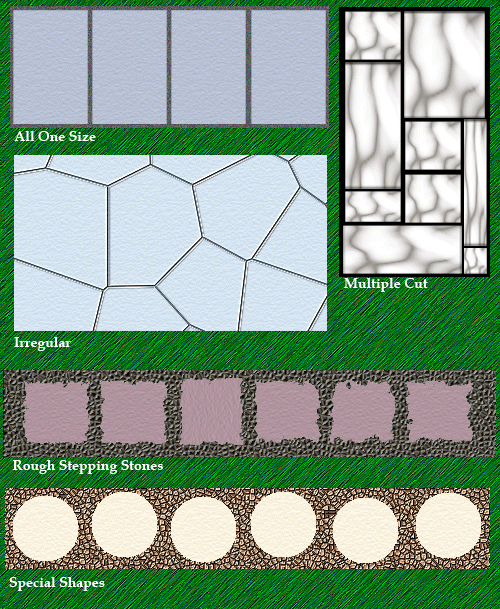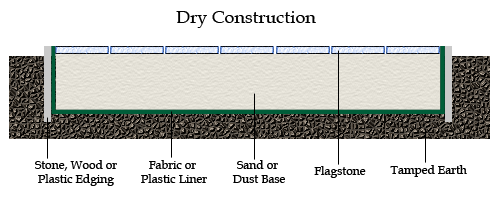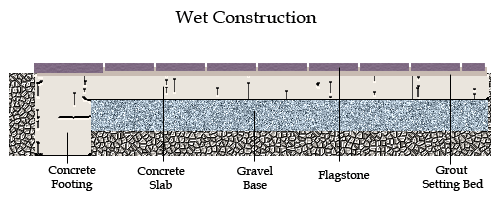| How To Build Patios & Walks |
|
Building a patio or walk with natural flagstone is an easy way to add to your home’s usefulness, appearance and resale value. The satisfaction of doing the job yourself is extremely rewarding and it is economical as well. There are two methods for building a patio or walk - wet and dry construction. In wet construction, you set the stone in a grout setting bed on a concrete slab. In dry construction, you use only a sand base in which to set the stone. Both methods are described here. Dry Construction Dry construction is more suited for an average handyman in that it requires less technical knowledge and equipment. First, the size of patio or walk should be determined and laid out with string and stakes. Then, the earth should be excavated to a depth of approximately four inches. While the edging on a patio, as shown in the sketch below, is not essential, it does make it easier to set the stone as well as retain the sand if the patio is raised above the grass. A stone edging, approximately 1 1/2 x 6 inches can be used or a wood edge, either 1 x 6 inches or 1 x 10 inches, can be staked into the earth as shown. When setting the edging, care should be taken to make sure it is level. This will eliminate problems later on when setting the flagstone.
Wet and tamp the earth in the excavated area and fill with sand to approximately 1 inch from the top edging. Now, starting in one corner, begin to lay the flagstones on the sand base tamping each piece with a rubber hammer or a block of wood. If the stone sinks too far into the sand, it must be picked up and more sand placed under it. If the stone does not sink level with the edging, it must be picked up and sand scraped away from under it. By placing a straight board across the edging you can determine if each stone is level. When all the stones are laid, sand should be placed on the patio and swept into all the joints. An alternate way to fill the joints is to use crushed stone or decorative gravel. This added touch can enhance the beauty of the patio even more. One thing to keep in mind when choosing stone for your patio laid in sand, is that larger, thicker pieces will stay level longer than smaller, thinner pieces. By keeping joints to a minimum width, sand and gravel will more readily remain in place and maintenance of the patio will be relatively easy. Dust or earth may be substituted for sand. Wet Construction Wet construction is slightly more costly than the dry method. However, the wet method does yield a permanent, maintenance free patio. The basic ingredients of this type of construction are a 4 inch gravel base, a 4 inch reinforced concrete slab, concrete footing to frost line around the perimeter, and the flagstone set in a 1 inch grout setting bed. First, as in dry construction, the patio should be laid out with string and stakes. Then the earth is excavated for a depth of approximately 6 inches as shown in the sketch below. Then, around the perimeter a trench should be dug the width of a shovel to the depth of the frost line in your locality. Some area climates will not require that a footing be necessary. After excavation is complete, set up form boards around the perimeter setting the top of the form where the finished patio will be. At this point, care should be taken to allow for drainage off the patio, so water will not remain after a storm. A pitch of 1/4" for every foot will be sufficient for drainage. The form boards should be set to take in this pitch of the patio. Now we are ready for the gravel base. The gravel should be placed in the excavated area leaving approximately 6 inches shown all around the form boards. After the reinforcing mesh wire is placed over the gravel we are ready for concrete. Using a mix which consists of one part cement, two parts sand, and three parts gravel, pour this concrete to within 2 inches from the top of the framework. Spread the concrete with a rake pulling the reinforced wire up with the rake so that it rests in the concrete rather than on the gravel where it was placed. No toweling or smoothing is necessary since a rough surface is desirable to provide a firm bond for the grout setting bed which will be applied next.
After letting the concrete slab harden (at least 24 hours) we are ready to set the flagstones. A grout setting bed mix, consisting of one part cement and three parts sand is mixed with water to a consistency that could be balled and thrown as that of a snowball. This is then spread over the concrete approximately 1 inch thick. Then each stone is laid and tamped level. Spread only enough mortar for one or two stones at a time and tamp each one lightly by hammering with a rubber faced mallet or block of wood. You can make sure each stone is level by using a long straight board placed across the framework. After a dozen or so stones are laid, each one is picked up one at a time and a cement “butter” is poured over the grout and the stone dropped back in place. This “butter” consists of cement and water mixed in a bucket to the consistency of pea soup. This adheres the dry stone to the fairly dry grout which otherwise would not bond very strongly. When setting stones into the grout, no attempt should be made to fill the spaces or joints between them. These joints are not filled until after all flagstones have been laid and the entire job has been allowed to set at least overnight. Mortar joints can even be filled in one day later. For filling joints, a mixture of one part cement and two parts sand should be mixed to a consistency a little wetter than the setting bed. A pointing tool should be used to pack the joints tightly. Use care no to smear cement over the flagstone. If cement does get on the stones, it should be washed off, using a sponge and water, as soon as possible before it hardens permanently. |


